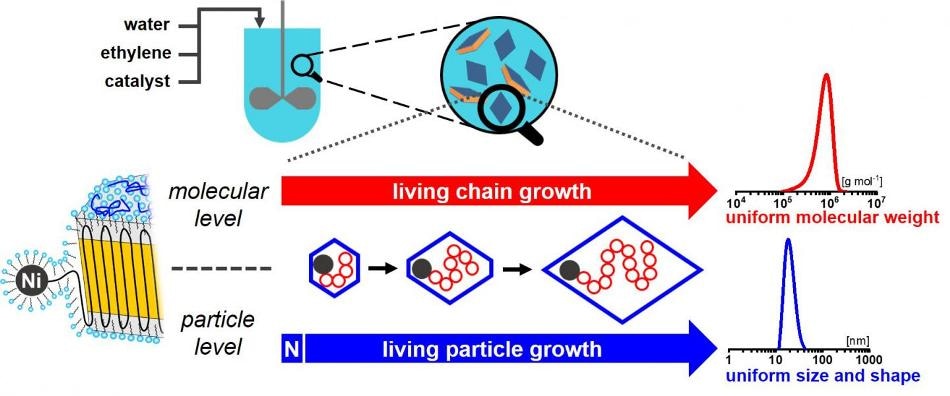Jun 14 2019
A research group from the University of Konstanz’s CRC 1214 “Anisotropic Particles as Building Blocks: Tailoring Shape, Interactions and Structures,” has shown a new aqueous polymerization process for producing polymer nanoparticles with a single chain and uniform shape.
 Concept to obtain uniform size and shape particles by controlled polymerization on a molecular as well as particle level. (Image credit: Stefan Mecking and Manuel Schnitte)
Concept to obtain uniform size and shape particles by controlled polymerization on a molecular as well as particle level. (Image credit: Stefan Mecking and Manuel Schnitte)
In contrast to earlier techniques, the new technique includes high particle concentrations. The CRC 1214 has been funded by the German Research Foundation (DFG) since 2016.
A corresponding paper titled “Uniform shape monodisperse single chain nanocrystals by living aqueous catalytic polymerization” is scheduled for open access online publication in Nature Communications on June 13th, 2019.
Nanoparticles are the basic elements of proposed nanoparticle-based materials with yet-to-be-attained mechanical, optical, and electronic properties. In order to develop nanomaterials, nanoparticles with uniform sizes and shapes are needed. Although it is possible to produce inorganic metal or metal oxide nanoparticles suitable for assembly in different shapes, it has been very complicated so far to produce polymer nanoparticles in shapes apart from spheres.
In previous approaches, single-chain particles were prepared by post-polymerization collapse or assembled from solutions of separately synthesized chains. What we have managed to do is to demonstrate direct polymerization to single-chain uniform-shape monodisperse nanocrystals for polyethylene, which is the largest and most important synthetic polymer material.
Stefan Mecking, Professor of Chemical Materials Science, Department of Chemistry, University of Konstanz
Stefan Mecking is the Vice Speaker of CRC 1214.
One main problem in relation to this method is to attain living chain and particle growth that can be continued for many hours and up to extremely high molecular weights, preferably yielding single-chain nanocrystals of ultra-high molecular weight polyethylene. In order to realize this, the scientists created advanced catalysts.
“We then conducted a series of pressure reactor tests to identify ideal conditions for maintaining catalytic activity over longer periods of time and to gain insights into the chain and particle growth process,” describes Mecking. “In addition to the novel catalysts, control of the colloidal state of the reaction mixture is another key element in obtaining the desired aqueous particle dispersions.”
Unlike most post-polymerization processes, the aqueous polymerization process explained by Stefan Mecking and his colleagues produces high particle number densities, which are similar to commercial polymer dispersions used for paints, coatings, and other applications. With transmission electron microscopy (TEM), the scientists were able to prove that the particles consequently produced are made up of a single chain, exhibit a uniform shape and size distribution, and do not amass.
“While our assemblies may not fully match the extensively optimized assemblies of inorganic nanoparticles, they seem to be very promising,” concludes Mecking. “In time, our insights into the creation of anisotropic polymer nanocrystals using aqueous catalytic polymerization may enable us to create polymer materials based on nanoparticle assembly.”